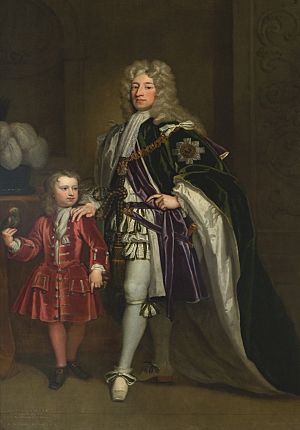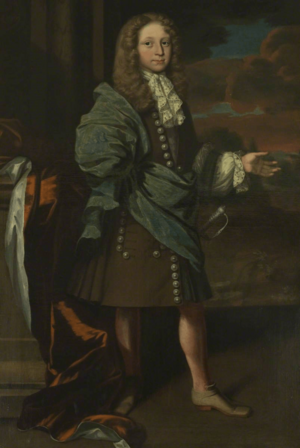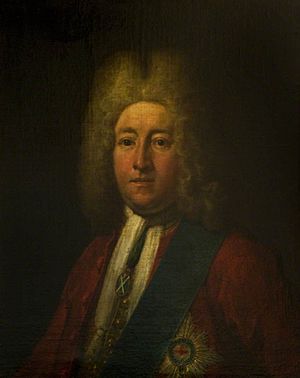John Erskine, Earl of Mar (1675–1732) facts for kids
Quick facts for kids
The Earl of Mar
|
|
|---|---|
 |
|
| Secretary of State for Scotland | |
| In office 1707–1709 |
|
| Monarch | Anne |
| Preceded by | Office established |
| Succeeded by | James Douglas, 2nd Duke of Queensberry |
| In office 1713–1714 |
|
| Monarch | Anne |
| Preceded by | The 2nd Duke of Queensberry |
| Succeeded by | The 1st Duke of Montrose |
| Jacobite Secretary of State | |
| In office 1716–1724 |
|
| Monarch | James Francis Edward Stuart |
| Preceded by | The 1st Viscount Bolingbroke |
| Succeeded by | John Hay, Duke of Inverness |
| Personal details | |
| Born | 1675 Scotland |
| Died | May 1732 Imperial city of Aix-la-Chapelle, Holy Roman Empire |
| Spouses |
Lady Margaret Hay
(m. 1703; died 1707)Lady Frances Pierrepont |
| Children | Thomas Erskine, Lord Erskine |
| Parents | Charles Erskine, Earl of Mar Mary Maule |
| Military service | |
| Battles/wars | Jacobite rising of 1715 |
John Erskine, 23rd and 6th Earl of Mar (1675–May 1732), was an important Scottish leader. He was known as the Earl of Mar and was nicknamed Bobbing John. This nickname came from his habit of changing sides in politics. He would switch between different groups, like the Tories and the Whigs, or between supporting the Jacobites and the Hanoverian kings.
John Erskine inherited his family's lands, but they came with many debts. In 1714, he lost his job when a new king, George I, came to power. This made him angry, and he decided to lead a rebellion. He wanted to bring back the old royal family, the Stuarts, who were known as the Jacobites.
In 1715, Mar led his forces in the Jacobite rising of 1715. He fought in the Battle of Sheriffmuir in November 1715. Even though his army was larger, he didn't win a clear victory. After this, his cause was lost, and he had to escape to France. He lived there for the rest of his life. The government in Britain declared him a traitor in 1716, and this punishment lasted for many years. He passed away in 1732.
Contents
Early Life and Politics
In the early 1700s, John Erskine was involved in Scottish politics. He supported the government at the time. He helped with the Act of Union 1707, which joined Scotland and England into Great Britain. After the Union, he became a Scottish Secretary of State. This was a very important job. He also became a representative peer for Scotland, meaning he represented Scotland's nobles in the British Parliament.
Later, in 1713, a different political group called the Tories made him a British Secretary of State. However, he seemed willing to work with the Whigs, another political group. When King George I became king in 1714, Mar quickly promised his loyalty. But like many Tories, he lost his job. This made him turn against the new king.
In August 1715, Mar secretly traveled to Scotland. There, he took charge of the Jacobites. These were people who supported James Francis Edward Stuart, also known as the Old Pretender. They believed James should be king instead of George I.
The 1715 Jacobite Rising
Mar met with many Highland chiefs in Scotland. He told them he wanted Scotland to be independent. On September 6, 1715, at Braemar, he announced that James VIII was the rightful King of Scotland, England, France, and Ireland. This act officially started the Jacobite rising of 1715.
More and more people joined Mar's army. However, he wasn't a very good military leader. He wasted valuable time at Perth. A planned attack on Stirling didn't work out. He also couldn't help the Jacobites in England very much.
At the Battle of Sheriffmuir in November 1715, Mar's army was much bigger than the army led by the Duke of Argyll. The battle itself didn't have a clear winner. But because Mar was indecisive, the Jacobites lost their chance to win. This battle was a major setback for their rebellion.
Life in Exile
After the battle, Mar met with James Francis Edward Stuart at Fetteresso. It was clear their rebellion had failed. Mar and James then fled to France. Mar would spend the rest of his life living outside of Britain.
In 1716, the British Parliament declared Mar a traitor. This meant he lost his rights and property as punishment for his disloyalty. This punishment was not removed until 1824. In France, Mar became the Jacobite Secretary of State. He tried to get other countries to support the Stuarts' claim to the throne.
Over time, however, many Jacobites began to lose trust in Mar. He tried to plan another invasion of Britain with Spain in 1719, but bad weather stopped it. He also received money from King George I, which made some people suspicious. In 1724, James Francis Edward Stuart finally ended his relationship with Mar. Mar spent his last years in Paris and Aix-la-Chapelle, where he died in 1732.
Family Life
John Erskine married his first wife, Lady Margaret Hay, on April 6, 1703. She was the daughter of Thomas Hay, 7th Earl of Kinnoull. They had a son named Thomas Erskine, Lord Erskine in 1705. Lady Margaret passed away on April 26, 1707.
Mar then married his second wife, Lady Frances Pierrepont. Her father was Evelyn Pierrepont, 1st Duke of Kingston-upon-Hull. This marriage helped Mar financially, allowing him to start paying off his family's old debts. Lady Frances faced difficulties due to the stress of his exile. She lived much longer than Mar, passing away on March 4, 1767.
Notable Relatives
- Through his second marriage, Mar was the brother-in-law of Lady Mary Wortley Montagu, a famous writer.
- Mar's brother, James Erskine, Lord Grange, was a well-known judge.
- Mar's son, Thomas Erskine, Lord Erskine, held an important position as Grand Master of the Grand Lodge of Scotland from 1749 to 1750.
- Robert Erskine (physician) was a doctor who worked as a librarian for Peter the Great, the Russian emperor.



